Evaluating the Impact of Geoeducation Programs on Student Learning and Geoheritage Awareness in Greece
Abstract
1. Introduction
2. Methodology
2.1. Research Design
2.2. Educational Methodology
2.2.1. Inquiry-Based Learning (IBL)
2.2.2. Place-Based Education
2.2.3. Hands-On Geological Fieldwork and Digital Tools
2.2.4. Bloom’s Taxonomy and Modern Pedagogical Approaches
2.3. Description of the Geoeducational Program
2.4. Justification of the Choice of Kalymnos and Nisyros for the Geoeducational Program on Caves
3. Results
3.1. Results of the Pre-Test (Questionnaire A)
3.2. Results of the Post-Test (Questionnaire B)
4. Discussion
4.1. Insights into the Current State and Impact of Geoeducation in Greece
4.2. Proposal for the Integration of Geoeducation into the Greek Curriculum
5. Conclusions
Author Contributions
Funding
Data Availability Statement
Acknowledgments
Conflicts of Interest
Appendix A
- 001.
- Educational status
- 001.1
- I am pupil in a junior high school
- 001.2
- I am teacher in a junior high school
- 002.
- Gender
- 002.1
- Female
- 002.2
- Male
- 003.
- Am I aware of the geological situation of the area in which I live?Yes No
- 004.
- I have visited the areas with strong geological features in my place of residence:Yes No
- 005.
- I know basic information about the wider geological feature of my area because I studied a book of:
- 005.1
- Geology–Geography
- 005.2
- History
- 005.3
- Wider bibliographic sources
- 005.4
- I do not know
- 006.
- The course of Geology–Geography is taught by:
- 006.1
- Geologist
- 006.2
- Physicist
- 006.3
- Chemist
- 006.4
- Biologist
- 006.5
- Other specialty: __________
- 007.
- Participation in programs:
- 007.1
- I have participated in a school geoenvironmental educational program
- 007.2
- I have participated in other types of educational programs
- 007.3
- I have participated in an extracurricular environmental program
- 007.4
- I have not participated in any environmental or educational program
- 008.
- I am aware of the geological evolution of Greece:Yes No
- 009.
- I am aware of Greek volcanic arc and its main areas:Yes No
- 010.
- Why does Greece have strong seismicity?
- 010.1
- Because of its volcanoes
- 010.2
- Due to climatic conditions
- 010.3
- Due to the point of convergence of lithospheric plates
- 010.4
- Because of its rocks
- 011.
- I am aware of the term geosite:Yes No
- 012.
- I am aware of the term geopark and its meaning:Yes No
- 013.
- I am aware of the term geoheritage and its meaning:Yes No
- 014.
- I am aware of the term geodiversity:Yes No
- 015.
- I am aware of the term geoconservation:Yes No
- 016.
- I know if Greece has geoparks:Yes No
- 017.
- I am aware of the term sustainable development and its benefits:Yes No
- 018.
- Have you ever heard of geoeducation?Yes NoIf so, please state: __________
- 019.
- I know the role and importance of geoeducation:Yes No
- 020.
- I am aware of various geoeducational activities:Yes NoIf so, please list some: __________
- 021.
- I am aware of the term geoethics and its meaning:Yes No
- 022.
- I believe that geoeducation can contribute positively to a society:Yes NoIf so, please state how: __________
- 023.
- I am engaged in geoeducational activities:Yes No
- 024.
- I know how many geoparks Greece has and where they are located:Yes No
- 025.
- I think that geoeducation is also connected with cultural or archaeological values:Yes No
- 001.
- Educational status
- 001.1
- I am pupil in a junior high school
- 001.2
- I am teacher in a junior high school
- 002.
- Gender
- 002.1
- Female
- 002.2
- Male
- 003.
- How do you think geoeducation will be developed and spread?
- 003.1
- Through intramural activities and similar geoeducational programs
- 003.2
- Through a document that will contain its meaning and dimensions
- 003.3
- Through extracurricular geoenvironmental activities
- 003.4
- Through initiatives of the municipality or the local community
- 004.
- You consider the term geoeducation to be mainly related:
- 004.1
- To the transmission of knowledge about geological features and processes
- 004.2
- To the protection of the environment
- 004.3
- To the sensitivity of citizens for the rational utilization of an area with strong geological characteristics
- 004.4
- To the development of activities that will bring an influx of tourists to an area
- 005.
- You consider the term geoheritage is related to:
- 005.1
- The recording and mapping of areas of intense geological interest
- 005.2
- The protection of areas of high environmental value
- 005.3
- The management of areas of high geological value
- 005.4
- The sustainable development
- 006.
- You consider the term geoconservation is associated with:
- 006.1
- A set of actions that contribute to the conservation and rational management of areas of geological interest
- 006.2
- The protection of the environment
- 006.3
- The principles of sustainable development
- 006.4
- The management and development of geotourism areas
- 007.
- You consider the term geoethics is related to:
- 007.1
- The interaction of environment and human activity
- 007.2
- The rational management of the ecosystem
- 007.3
- The exploitation of areas of high geological interest
- 007.4
- The development of sustainability
- 008.
- You consider the term geosite is associated with:
- 008.1
- A site of strong geological and geomorphological interest
- 008.2
- A site where special geological rocks are found
- 008.3
- A place where extremely rare fossils are found
- 008.4
- An area where rare species of flora and fauna are found
- 009.
- You consider the term geopark is connected to:
- 009.1
- An area containing a set of several points and sites of high geological interest
- 009.2
- A site that must be environmentally protected
- 009.3
- An area showing geotourism development
- 009.4
- An area where several biotic and abiotic factors are found
- 010.
- In your opinion, what is the most important sector that geoeducation should develop (choose more than one answer):
- 010.1
- Geoscientific knowledge
- 010.2
- Awareness regarding natural disasters
- 010.3
- Rational use of mineral wealth
- 010.4
- Awareness of sustainable development and its applications
- 010.5
- Awareness of geoheritage
- 010.6
- Awareness of geoconservation and environmental protection
- 010.7
- Awareness of geoethics and its beneficial dimensions
- 011.
- Geotourism is a form of tourism:
- 011.1
- With the main object of geoeducational activities and visiting areas with high geological value
- 011.2
- With alternative activities (alternative tourism)
- 011.3
- For the development of tourism infrastructure
- 011.4
- Series of activities for the protection of the environment
| Please indicate (√) the Extent to Which You Agree with the Following Suggestions. | |||||
| 1: Strongly Disagree, 2: Disagree, 3: Neither Agree nor Disagree, 4: Agree, 5: Strongly Agree | 1 | 2 | 3 | 4 | 5 |
| 012. Do you think that the educational system contributes to the promotion of geoeducation? | ☐ | ☐ | ☐ | ☐ | ☐ |
| 013. Do you think there are geoeducational programs that will promote and highlight geoheritage at a national level? | ☐ | ☐ | ☐ | ☐ | ☐ |
| 014. Would you like to participate in geoeducational activities or programs? | ☐ | ☐ | ☐ | ☐ | ☐ |
| 015. Do you think that geoeducation will contribute to sustainable development? | ☐ | ☐ | ☐ | ☐ | ☐ |
| 016. Would you be interested in learning more about geoeducation? | ☐ | ☐ | ☐ | ☐ | ☐ |
| 017. Do you consider that geoeducation beyond geological values, transmits additional historical, archaeological values, etc.? | ☐ | ☐ | ☐ | ☐ | ☐ |
| 018. Do you think that geoeducation contributes to the economic development of an area? | ☐ | ☐ | ☐ | ☐ | ☐ |
| 019. Do you think that geoeducation contributes to the citizens’ awareness for the preservation and protection of the environment? | ☐ | ☐ | ☐ | ☐ | ☐ |
| 020. Do you think that geoeducational activities can change the standard of living of the citizens of a local community? | ☐ | ☐ | ☐ | ☐ | ☐ |
| 021. Do you think that geoeducational activities will contribute to geotourism development of an area? | ☐ | ☐ | ☐ | ☐ | ☐ |
| 022. Do you think that awareness of geoheritage value will contribute to the preservation and protection of the environment? | ☐ | ☐ | ☐ | ☐ | ☐ |
| 023. Do you think that awareness of geoheritage will contribute to the transmission of the principles of sustainable development? | ☐ | ☐ | ☐ | ☐ | ☐ |
| 024. Do you think that the transmission of the geoheritage value will contribute to the awareness of the citizens for the protection and utilization of the geological areas that show strong interest? | ☐ | ☐ | ☐ | ☐ | ☐ |
| 025. Do you think that geoeducation promotes various recreational activities? | ☐ | ☐ | ☐ | ☐ | ☐ |
Appendix B
| Question | Summarized Data | ||
|---|---|---|---|
| 001. Educational status | Pupils: 443 (88.80%) | Teachers: 55 (11.07%) | No answer: 1 (0.20%) |
| 002. Gender | Male: 241 (48.30%) | Female: 257 (51.50%) | No answer: 1 (0.20%) |
| 003. Am I aware of the geological situation of the area in which I live? | Yes499 (N): 316 (63.30%) | No499 (N): 172 (34.50%) | No answer499 (N): 11 (2.20%) |
| 004. I have visited the areas with strong geological features in my place of residence: | Yes499 (N): 290 (58.10%) | No499 (N): 204 (40.90%) | No answer499 (N): 5 (1.00%) |
| 005. I know basic information about the wider geological feature of my area because I studied a book on: | |||
| 005.1. Geology–Geography | Yes499 (N): 171 | Yes499 (%): 34.30 | |
| 005.2. History | Yes499 (N): 62 | Yes499 (%): 12.40 | |
| 005.3. Wider bibliographic sources | Yes499 (N): 54 | Yes499 (%): 10.80 | |
| 005.4. I do not know | Yes499 (N): 205 | Yes499 (%): 41.90 | |
| No answer | Yes499 (N): 3 | Yes499 (%): 0.60 | |
| 006. The course of Geology–Geography is taught by: | |||
| 006.1. Geologist | Yes499 (N): 249 | Yes499 (%): 49.90 | |
| 006.2. Physicist | Yes499 (N): 76 | Yes499 (%): 15.20 | |
| 006.3. Chemist | Yes499 (N): 34 | Yes499 (%): 6.80 | |
| 006.4. Βiologist | Yes499 ( N): 92 | Yes499 (%): 18.40 | |
| 006.5. Other specialty: __________ | Yes499 (N): 45 | Yes499 (%): 9.00 | |
| No answer | Yes499 (N): 3 | Yes499 (%): 0.60 | |
| 007. Participation in programs: | |||
| 007.1. I have participated in a school geoenvironmental educational program | Yes499 (N): 82 | Yes499 (%): 16.40 | |
| 007.2. I have participated in other types of educational programs | Yes499 (N): 115 | Yes499 (%): 23.00 | |
| 007.3. I have participated in an extracurricular environmental program | Yes499 (N): 62 | Yes499 (%): 12.40 | |
| 007.4. I have not participated in any environmental or educational program | Yes499 (N): 238 | Yes499 (%): 47.80 | |
| No answer | Yes499 (N): 2 | Yes499 (%): 0.40 | |
| 008. I am aware of the geological evolution of Greece: | Yes499 (N): 244 (48.90%) | No499 (N): 252 (50.50%) | No answer499 (N): 3 (0.60%) |
| 009. I am aware of Greek volcanic arc and its main areas: | Yes499 (N): 193 (38.70%) | No499 (N): 304 (60.90%) | No answer499 (N): 2 (0.40%) |
| 010. Why does Greece have strong seismicity? | |||
| 010.1. Because of its volcanoes | Yes499 (N): 53 | Yes499 (%): 10.60 | |
| 010.2. Due to climatic conditions | Yes499 (N): 53 | Yes499 (%): 10.60 | |
| 010.3 Due to the point of convergence of lithospheric plates | Yes499 (N): 339 | Yes499 (%): 67.90 | |
| 010.4 Because of its rocks | Yes499 (N): 48 | Yes499 (%): 9.70 | |
| No answer | Yes499 (N): 6 | Yes499 (%): 1.20 | |
| 011. I am aware of the term geosite: | Yes499 (N): 129 (25.90%) | No499 (N): 363 (72.70%) | No answer499 (N): 7 (1.40%) |
| 012. I am aware of the term geopark and its meaning: | Yes499 (N): 164 (32.90%) | No499 (N): 330 (66.10%) | No answer499 (N): 5 (1.00%) |
| 013. I am aware of the term geoheritage and its meaning | Yes499 (N): 130 (26.10%) | No499 (N): 362 (72.50%) | No answer499 (N): 7 (1.40%) |
| 014. I am aware of the term geodiversity | Yes499 (N): 138 (27.70%) | No499 (N): 355 (71.10%) | No answer499 (N): 6 (1.20%) |
| 015. I am aware of the term geoconservation | Yes499 (N): 147 (29.50%) | No499 (N): 346 (69.30%) | No answer499 (N): 6 (1.20%) |
| 016. I know if Greece has geoparks | Yes499 (N): 225 (45.10%) | No499 (N): 268 (53.70%) | No answer499 (N): 6 (1.20%) |
| 017. I am aware of the term sustainable development and its benefits: | Yes499 (N): 221 (44.30%) | No499 (N): 275 (55.10%) | No answer499 (N): 3 (0.60%) |
| 018. Have you ever heard of geoeducation? | Yes499 (N): 82 (16.40%) | No499 (N): 415 (83.20%) | No answer499 (N): 2 (0.40%) |
| 019. I know the role and importance of geoeducation | Yes499 (N): 88 (17.60%) | No499 (N): 405 (81.20%) | No answer499 (N): 6 (1.20%) |
| 020. I am aware of various geoeducational activities | Yes499 (N): 64 (12.80%) | No499 (N): 430 (86.20%) | No answer499 (N): 5 (1.00%) |
| 021. I am aware of the term geoethics and its meaning | Yes499 (N): 77 (15.40%) | No499 (N): 418 (83.80%) | No answer499 (N): 4 (0.80%) |
| 022. I believe that geoeducation can contribute positively to a society | Yes499 (N): 211 (42.30%) | No499 (N): 276 (55.30%) | No answer499 (N): 12 (2.40%) |
| 023. I am engaged in geoeducational activities | Yes499 (N): 102 (20.40%) | No499 (N): 396 (79.40%) | No answer499 (N): 1 (0.20%) |
| 024. I know how many geoparks Greece has and where they are located | Yes499 (N): 80 (16.00%) | No499 (N): 417 (83.60%) | No answer499 (N): 2. (0.40%) |
| 025. I think that geoeducation is also connected with cultural or archaeological values | Yes499 (N): 306 (61.30%) | No499 (N): 190 (38.10%) | No answer499 (N): 3 (0.60%) |
| Question | Summarized Data | ||
|---|---|---|---|
| 001. Educational status | Pupils: 443 (88.80%) | Teachers: 55 (11.07%) | No answer: 1 (0.20%) |
| 002. Gender | Male: 241 (48.30%) | Female: 257 (51.50%) | No answer: 1 (0.20%) |
| 003. How do you think geoeducation will be developed and spread? | |||
| 003.1. Through intramural activities and similar geoeducational programs | Yes499 (N): 259 | Yes499 (%): 51.90 | |
| 003.2. Through a document that will contain its meaning and dimensions | Yes499(N): 48 | Yes499 (%): 9.60 | |
| 003.3. Through extracurricular geoenvironmental activities | Yes499 (N): 91 | Yes499(%): 18.20 | |
| 003.4. Through initiatives of the municipality or the local community | Yes499 (N): 92 | Yes499 (%): 18.50 | |
| No answer | Yes499 (N): 9 | Yes499 (%): 1.80 | |
| 004. You consider the term geoeducation to be mainly related: | |||
| 004.1. To the transmission of knowledge about geological features and processes | Yes499 (N): 222 | Yes499 (%): 44.50 | |
| 004.2. To the protection of the environment | Yes499 (N): 131 | Yes499 (%): 26.30 | |
| 004.3. To the sensitivity of citizens for the rational utilization of an area with strong geological characteristics | Yes499 (N): 109 | Yes499 (%): 21.80 | |
| 004.4. To the development of activities that will bring an influx of tourists to an area | Yes499 (N): 30 | Yes499 (%): 6.00 | |
| No answer | Yes499 (N): 7 | Yes499 (%): 1.40 | |
| 005. You consider the term geoheritage is related to: | |||
| 005.1. The recording and mapping of areas of intense geological interest | Yes499 (N): 146 | Yes499 (%): 29.30 | |
| 005.2. The protection of areas of high environmental value | Yes499 (N): 145 | Yes499 (%): 29.10 | |
| 005.3. The management of areas of high geological value | Yes499 (N): 116 | Yes499 (%): 23.20 | |
| 005.4. The sustainable development | Yes499 (N): 84 | Yes499 (%): 16.80 | |
| No answer | Yes499 (N): 8 | Yes499 (%): 1.60 | |
| 006. You consider the term geoconservation is associated with: | |||
| 006.1. A set of actions that contribute to the conservation and rational management of areas of geological interest | Yes499 (N): 197 | Yes499 (%): 39.50 | |
| 006.2. The protection of the environment | Yes499 (N): 180 | Yes499 (%): 36.10 | |
| 006.3. The principles of sustainable development | Yes499 (N): 54 | Yes499 (%): 10.80 | |
| 006.4. The management and development of geotourism areas | Yes499 (N): 59 | Yes499 (%): 11.80 | |
| No answer | Yes499 (N): 9 | Yes499 (%): 1.80 | |
| 007. You consider the term geoethics is related to: | |||
| 007.1. The interaction of environment and human activity | Yes499 (N): 186 | Yes499 (%): 37.30 | |
| 007.2. The rational management of the ecosystem | Yes499 (N): 127 | Yes499 (%): 25.50 | |
| 007.3. The exploitation of areas of high geological interest | Yes499 (N): 117 | Yes499 (%): 23.40 | |
| 007.4. The development of sustainability | Yes499 (N): 58 | Yes499 (%): 11.60 | |
| No answer | Yes499 (N): 11 | Yes499 (%): 2.20 | |
| 008. You consider the term geosite is associated with: | |||
| 008.1. A site of strong geological and geomorphological interest | Yes499 (N): 209 | Yes499 (%): 41.90 | |
| 008.2. A site where special geological rocks are found | Yes499 (N): 141 | Yes499 (%): 28.30 | |
| 008.3. A place where extremely rare fossils are found | Yes499 (N): 72 | Yes499 (%): 14.40 | |
| 008.4. An area where rare species of flora and fauna are found | Yes499 (N): 67 | Yes499 (%): 13.40 | |
| No answer | Yes499 (N): 10 | Yes499 (%): 2.00 | |
| 009. You consider the term geopark is connected to: | |||
| 009.1. An area containing a set of several points and sites of high geological interest | Yes499 (N): 209 | Yes499 (%): 41.90 | |
| 009.2. A site that must be environmentally protected | Yes499 (N): 120 | Yes499 (%): 24.00 | |
| 009.3. An area showing geotourism development | Yes499 (N): 99 | Yes499 (%): 19.80 | |
| 009.4. An area where several biotic and abiotic factors are found | Yes499 (N): 64 | Yes499 (%): 12.90 | |
| No answer | Yes499 (N): 7 | Yes499 (%): 1.40 | |
| 010. In your opinion, what is the most important sector that geoeducation should develop (choose more than one answer): | |||
| 010.1. Geoscientific knowledge | Yes499 (N): 255 | Yes499 (%): 51.10 | |
| 010.2. Awareness regarding natural disasters | Yes499 (N): 170 | Yes499 (%): 34.06 | |
| 010.3. Rational use of mineral wealth | Yes499 (N): 128 | Yes499 (%): 25.65 | |
| 010.4. Awareness of sustainable development and its applications | Yes499 (N): 96 | Yes499 (%): 19.23 | |
| 010.5. Awareness of geoheritage | Yes499 (N): 206 | Yes499 (%): 41.28 | |
| 010.6. Awareness of geoconservation and environmental protection | Yes499 (N): 231 | Yes499 (%): 46.29 | |
| 010.7. Awareness of geoethics and its beneficial dimensions | Yes499 (N): 116 | Yes499 (%): 23.24 | |
| No answer | Yes499 (N): 7 | Yes499 (%): 1.40 | |
| 011. Geotourism is a form of tourism: | |||
| 011.1. With the main object of geoeducational activities and visiting areas with high geological value | Yes499 (N): 233 | Yes499 (%): 46.90 | |
| 011.2. With alternative activities (alternative tourism) | Yes499 (N): 130 | Yes499 (%): 26.10 | |
| 011.3. For the development of tourism infrastructure | Yes499 (N): 69 | Yes499 (%): 13.80 | |
| 011.4. Series of activities for the protection of the environment | Yes499 (N): 55 | Yes499 (%): 12.00 | |
| No answer | Yes499 (N): 7 | Yes499 (%): 1.40 | |
| 012. Do you think that the educational system contributes to the promotion of geoeducation? | M * (N499) = 2.1 | ||
| 013. Do you think there are geoeducational programs that will promote and highlight geoheritage at a national level? | M * (N499) = 3.7 | ||
| 014. Would you like to participate in geoeducational activities or programs? | M * (N499) = 3.5 | ||
| 015. Do you think that geoeducation will contribute to sustainable development? | M * (N499) = 3.6 | ||
| 016. Would you be interested in learning more about geoeducation? | M * (N499) = 3.6 | ||
| 017. Do you consider that geoeducation beyond geological values, transmits additional historical, archaeological values, etc.? | M * (N499) = 3.5 | ||
| 018. Do you think that geoeducation contributes to the economic development of an area? | M * (N499) = 4.0 | ||
| 019. Do you think that geoeducation contributes to the citizens’ awareness for the preservation and protection of the environment? | M * (N499) = 3.6 | ||
| 020. Do you think that geoeducational activities can change the standard of living of the citizens of a local community? | M * (N499) = 3.4 | ||
| 021. Do you think that geoeducational activities will contribute to geotourism development of an area? | M * (N499) = 3.6 | ||
| 022. Do you think that awareness of geoheritage value will contribute to the preservation and protection of the environment? | M * (N499) = 3.5 | ||
| 023. Do you think that awareness of geoheritage will contribute to the transmission of the principles of sustainable development? | M * (N499) = 3.9 | ||
| 024. Do you think that the transmission of the geoheritage value will contribute to the awareness of the citizens for the protection and utilization of the geological areas that show strong interest? | M * (N499) = 3.5 | ||
| 025. Do you think that geoeducation promotes various recreational activities? | M * (N499) = 3.6 | ||
References
- Brilha, J.B.R.; Reynard, E. Geoheritage and geoconservation: The challenges. In Geoheritage; Reynard, E., Brihla, J., Eds.; Elsevier: Amsterdam, The Netherlands, 2018; pp. 431–438. [Google Scholar] [CrossRef]
- Zafeiropoulos, G.; Drinia, H.; Antonarakou, A.; Zouros, N. From geoheritage to geoeducation, geoethics and geotourism: A critical evaluation of the Greek region. Geosciences 2021, 11, 381. [Google Scholar] [CrossRef]
- Martini, G. (Ed.) Actes du premier symposium international sur la protection au patrimonie geologique. In Memoires de la Societe 656 Geologique de France, Proceedings of the First Symposium on Earth Heritage Conservation, 11–16 June 1991; Numero Special 165; Société géologique de France: Digne, France, 1993; 276p. [Google Scholar]
- Zouros, N. The European Geoparks Network. Episodes 2004, 27, 165–171. [Google Scholar] [CrossRef]
- Zouros, N.; Valiakos, I. Geoparks Management and Assessment. Bull. Geol. Soc. Greece 2017, 43, 965–977. [Google Scholar] [CrossRef]
- Herrera-Franco, G.; Montalván-Burbano, N.; Carrión-Mero, P.; Apolo-Masache, B.; Jaya-Montalvo, M. Research trends in geotourism: A bibliometric analysis using the scopus database. Geosciences 2020, 10, 379. [Google Scholar] [CrossRef]
- Ólafsdóttir, R.; Tverijonaite, E. Geotourism: A systematic literature review. Geosciences 2018, 8, 234. [Google Scholar] [CrossRef]
- Rokka, A. Geology in primary education; Potential and perspectives. Bull. Geol. Soc. Greece 2018, 34, 819–823. [Google Scholar] [CrossRef][Green Version]
- Meléndez, G.; Fermeli, G.; Koutsouveli, A. Analyzing Geology textbooks for secondary school curricula in Greece and 775 Spain: Educational use of geological heritage. Bull. Geol. Soc. Greece 2007, 40, 1819–1832. [Google Scholar] [CrossRef][Green Version]
- Trikolas, K.; Ladas, I. The necessity of teaching earth sciences in secondary education. In Proceedings of the 3rd International 777 GEOschools Conference, Teaching Geosciences in Europe from Primary to Secondary School, Athens, Greece, 28–29 September 2013; pp. 73–76. [Google Scholar]
- Fermeli, G.; Meléndez, G.; Calonge, A.; Dermitzakis, M.; Steininger, F.; Koutsouveli, A.; Neto de Carvalho, C.; Rodrigues, J.; D’Arpa, C.; Di Patti, C. GEOschools: Innovative teaching of geosciences in secondary schools and raising awareness on 781 geoheritage in the society. In Avances y Retos en la Conservación del 782 Patrimonio Geológico en España; Fernández-Martínez, E., y Castaño de Luis, R., Eds.; Actas de la IX Reunión Nacional de la Comisión de Patrimonio Geológico (Sociedad 783 Geológica de España); Universidad de León: León, Spain, 2011; pp. 120–124. ISBN 978-84-9773-578-0. [Google Scholar]
- Georgousis, E.; Savelides, S.; Mosios, S.; Holokolos, M.-V.; Drinia, H. The Need for Geoethical Awareness: The Importance of 785 Geoenvironmental Education in Geoheritage Understanding in the Case of Meteora Geomorphes, Greece. Sustainability 2021, 13, 6626. [Google Scholar] [CrossRef]
- Creswell, J.C.; Clark, V.P. Designing and Conducting Mixed Methods Research, 3rd ed.; Sage Publications: Thousand Oaks, CA, USA, 2018. [Google Scholar]
- Saraswati, P.; Devi, A. Mixed Methods-Research Methodology an Overview. Mathews J. Nurs. Health Care 2023, 5, 1–3. [Google Scholar] [CrossRef]
- Winlow, H.; Simm, D.; Marvell, A.; Schaaf, R. Using focus group research to support teaching and learning. In Pedagogic Research in Geography Higher Education; Routledge: London, UK, 2017; pp. 112–123. [Google Scholar]
- Campbell, S.; Greenwood, M.; Prior, S.; Shearer, T.; Walkem, K.; Young, S.; Bywaters, D.; Walker, K. Purposive sampling: Complex or simple? Research case examples. J. Res. Nurs. 2020, 25, 652–661. [Google Scholar] [CrossRef] [PubMed]
- Zafeiropoulos, G.; Drinia, H. Kalymnos Island, SE Aegean Sea: From Fishing Sponges and Rock Climbing to Geotourism Perspective. Heritage 2021, 4, 3126–3146. [Google Scholar] [CrossRef]
- Zafeiropoulos, G.; Drinia, H. Comparative Analysis of Two Assessment Methods for the Geoeducational Values of Geosites: A Case Study from the Volcanic Island of Nisyros, SE Aegean Sea, Greece. Geosciences 2022, 12, 82. [Google Scholar] [CrossRef]
- Mann, K.; MacLeod, A. Constructivism: Learning Theories and Approaches to Research. In Researching Medical Education; Cleland, J., Durning, S.J., Eds.; John Wiley & Sons, Ltd.: Hoboken, NJ, USA, 2015; pp. 49–66. [Google Scholar] [CrossRef]
- Geitz, G.; Donker, A.; Parpala, A. Studying in an Innovative Teaching–Learning Environment: Design-Based Education at a University of Applied Sciences. Learn. Environ. Res. 2024, 27, 17–35. [Google Scholar] [CrossRef]
- Salinas-Navarro, D.E.; Vilalta-Perdomo, E.; Michel-Villarreal, R.; Montesinos, L. Using Generative Artificial Intelligence Tools to Explain and Enhance Experiential Learning for Authentic Assessment. Educ. Sci. 2024, 14, 83. [Google Scholar] [CrossRef]
- Siddiq, F.; Olofsson, A.D.; Lindberg, J.O.; Tomczyk, L. What Will Be the New Normal? Digital Competence and 21st-Century Skills: Critical and Emergent Issues in Education. Educ. Inf. Technol. 2024, 29, 7697–7705. [Google Scholar] [CrossRef]
- Argyilan, E.; Huysken, K.; Votaw, R. Deconstructing a Geology Field Trip to Reconstruct Around a Pedagogical Framework: A Case Study on the Integration of Cognitive Learning Theories and Learning Progressions. J. Sch. Teach. Learn. 2024, 24, 58–75. [Google Scholar] [CrossRef]
- Boyd, P.; Hill, J. Working with Rubrics. In Academic Standards in Higher Education: Critical Perspectives and Practical Strategies; Taylor & Francis: Abingdon, UK, 2024. [Google Scholar]
- Maran, A. Geoconservation in Serbia-State of play and future perspectives. Eur. Geol. 2012, 34, 1–72. [Google Scholar]
- Peppoloni, S.; Di Capua, G. Geoethics: Ethical, Social, and Cultural Values in Geosciences Research, Practice, and Education. In Geoscience for the Public Good and Global Development: Toward a Sustainable Future, Geological Society of America, Special Papers; Greg, W., Jeff, G., Eds.; Geological Society of America: Boulder, CO, USA, 2016; pp. 17–21. [Google Scholar]
- Promduangsri, P.; Crookall, D. Geoethics education: From theory to practice—A case study. In Proceedings of the EGU General Assembly 2020, Online, 4–8 May 2020. [Google Scholar] [CrossRef]
- Gates, A.E. Benefits of a STEAM collaboration in Newark, New Jersey: Volcano simulation through a glass-making experience. J. Geosci. Educ. 2017, 65, 4–11. [Google Scholar] [CrossRef]
- Liritzis, I.; Mainzer, K.; Lavicza, Z.; Fenyvesi, K.; Dinescu, V.; Orlandi, S.; Yu, H.; Teodorescou-Ciocanea, L.; Elias, M.I.; Cosmopoulos, M.; et al. EASA Expert Group: Science, Technology, Engineering, Mathematics in Arts and Culture (STEMAC). Proc. Eur. Acad. Sci. Arts 2024, 3, 27. [Google Scholar] [CrossRef]
- Georgousis, E.; Savelides, S.; Drinia, H. Interdisciplinary Approach Research of STEM&HASS Educational Objects in Confronting Complex Environmental Problems. In Proceedings of the 8th Conference on Environmental Education for Sustainability in the Age of Climate Change, Patra, Greece, 11–13 September 2020. [Google Scholar]
- Mereli, A.; Niki, E.; Psycharis, S.; Drinia, H.; Antonarakou, A.; Mereli, M.; Maria, T. Education of students from Greek schools regarding natural disasters through STEAM. Eur. J. Math. Sci. Technol. Educ. 2023, 19, em2314. [Google Scholar] [CrossRef] [PubMed]
- Zafeiropoulos, G.; Drinia, H. A new quantitative assessment method for the geoeducational potential of the geodiversity. In Proceedings of the EGU General Assembly Conference Abstracts, Vienna, Austria, 23–28 May 2023; p. EGU23-8907. [Google Scholar] [CrossRef]
- Zafeiropoulos, G.; Drinia, H. GEOAM: A Holistic Assessment Tool for Unveiling the Geoeducational Potential of Geosites. Geosciences 2023, 13, 210. [Google Scholar] [CrossRef]
- Zafeiropoulos, G.; Drinia, H. Effectiveness of the Geoeducational Assessment Method (GEOAM) in Unveiling Geoeducational Potential: A Case Study of Samos. Geosciences 2023, 13, 336. [Google Scholar] [CrossRef]
- Koupatsiaris, A.A.; Drinia, H. Expanding Geoethics: Interrelations with Geoenvironmental Education and Sense of Place. Sustainability 2024, 16, 1819. [Google Scholar] [CrossRef]
- Georgousis, E.; Savelidi, M.; Savelides, S.; Mosios, S.; Holokolos, M.-V.; Drinia, H. How Greek Students Perceive Concepts Related to Geoenvironment: A Semiotics Content Analysis. Geosciences 2022, 12, 172. [Google Scholar] [CrossRef]
- Song, Y.I.K. Exploring connections between environmental education and ecological public art. Child. Educ. 2008, 85, 13–19. [Google Scholar] [CrossRef]
- Asah, S.T.; Bengston, D.N.; Westphal, L.M.; Gowan, C.H. Mechanisms of children’s exposure to nature: Predicting adulthood environmental citizenship and commitment to nature-based activities. Environ. Behav. 2018, 50, 807–836. [Google Scholar] [CrossRef]
- Chawla, L. Benefits of nature contact for children. J. Plan. Lit. 2015, 30, 433–452. [Google Scholar] [CrossRef]
- Gill, T. The benefits of children’s engagement with nature: A systematic literature review. Child. Youth Environ. 2014, 24, 10–34. [Google Scholar] [CrossRef]
- Miranda Orama, T.J. Art and Eco Therapies: Benefits to Motor Development of Preschool-Age Children in the Screen Era. Master’s Thesis, Lesley University, Cambridge, MA, USA, 2022. [Google Scholar]
- Kondyli, C.; Psychogiou, M.; Drinia, H. The Museums of Geology and Paleontology as Geoeducational Learning Environments for Raising Climate Change Awareness. Sustainability 2024, 16, 4481. [Google Scholar] [CrossRef]
- Fanioudaki, E.; Drinia, H.; Fassoulas, C. Geocultural Interactions in Minoan Crete: An Environmental Education Perspective through Drama Techniques. Sustainability 2024, 16, 907. [Google Scholar] [CrossRef]

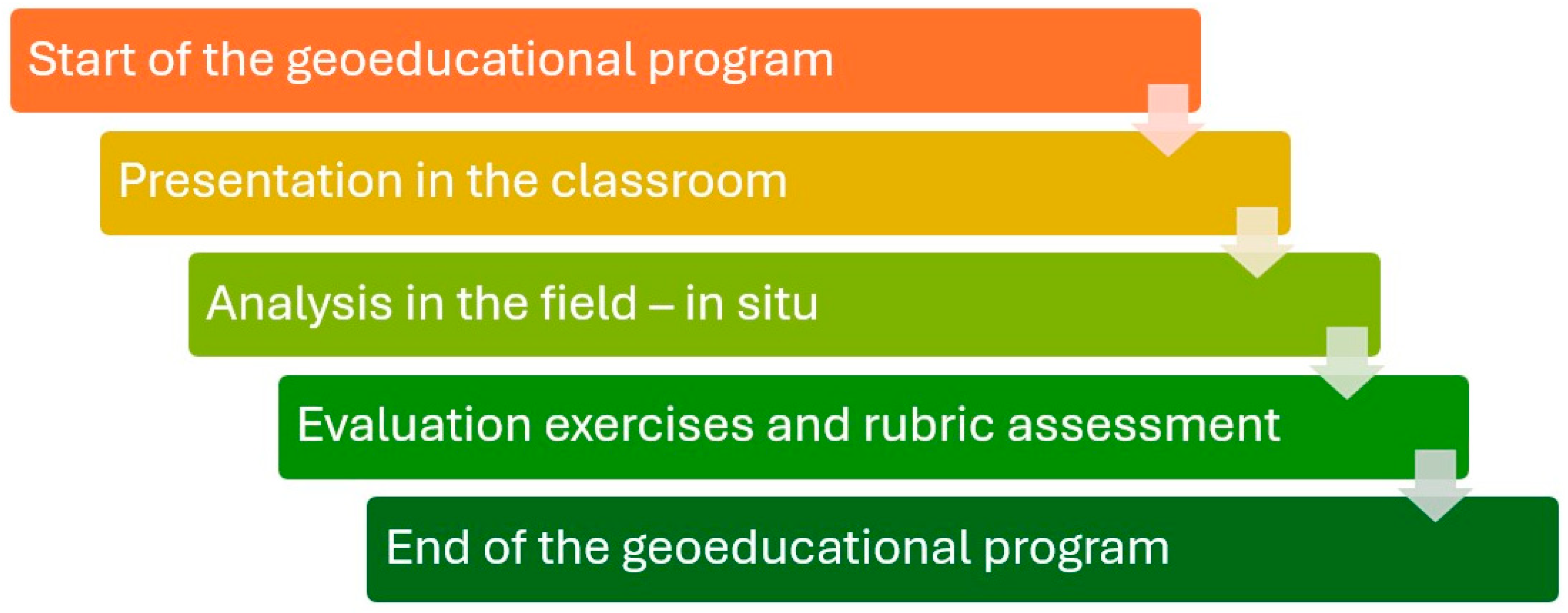

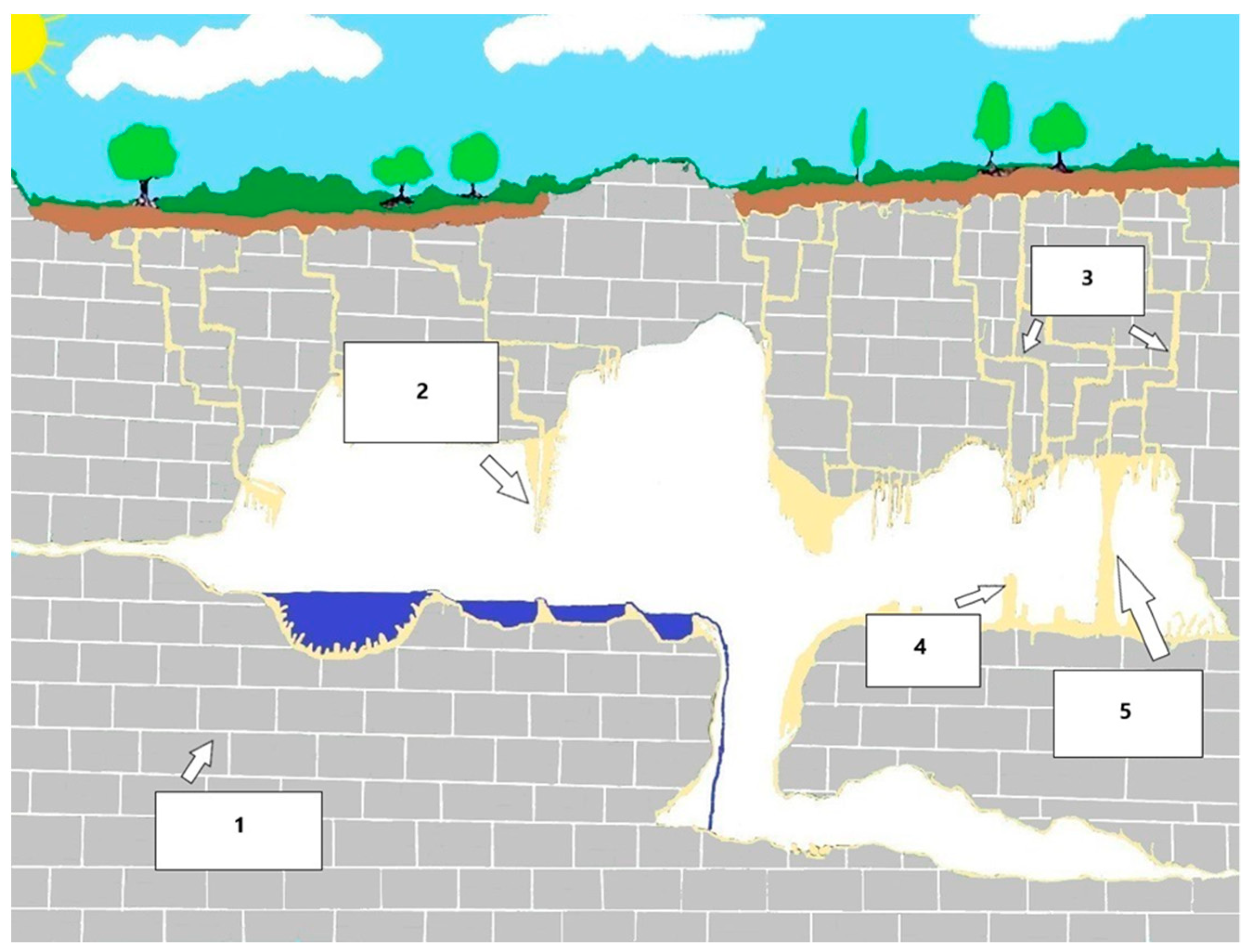
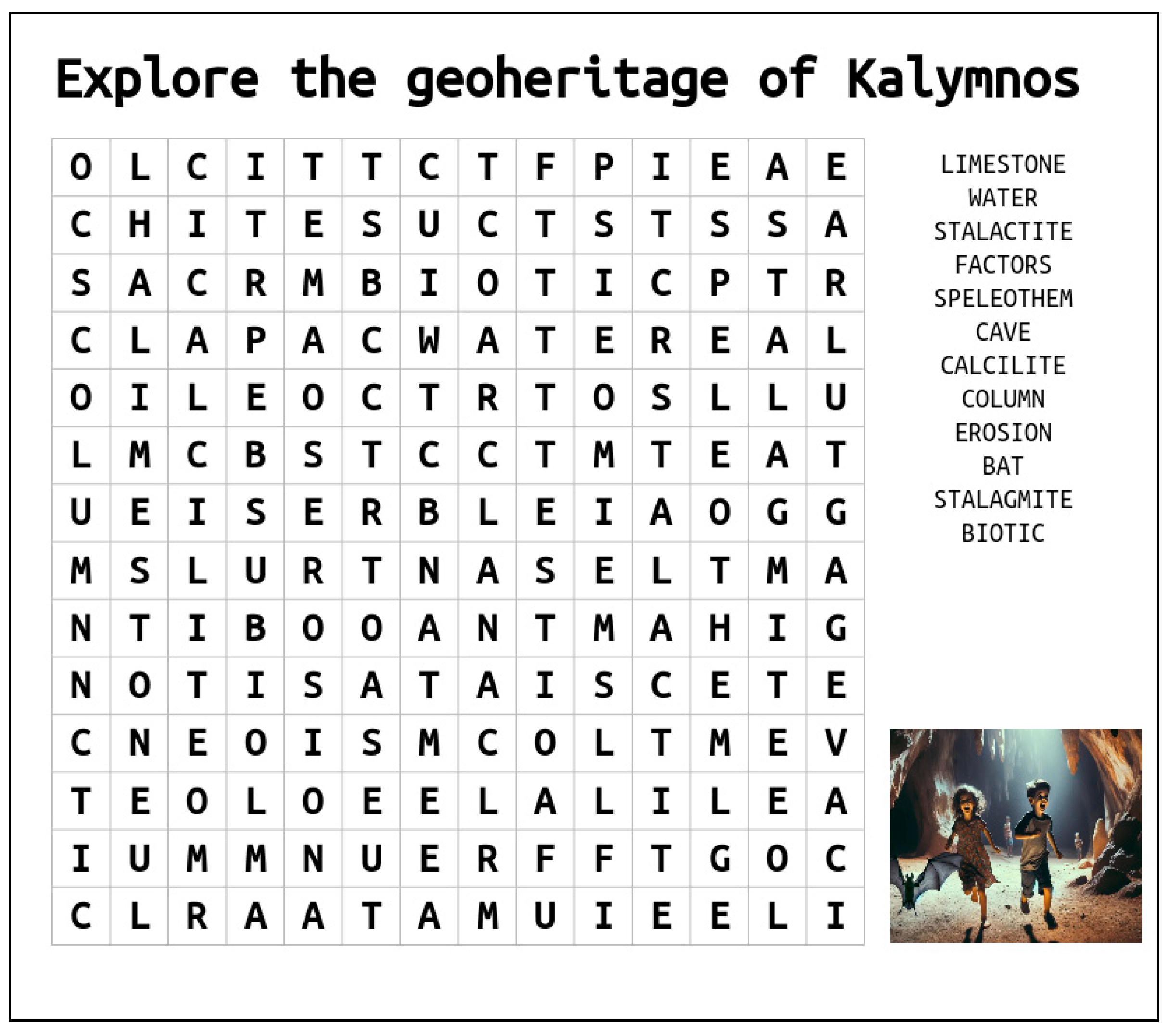
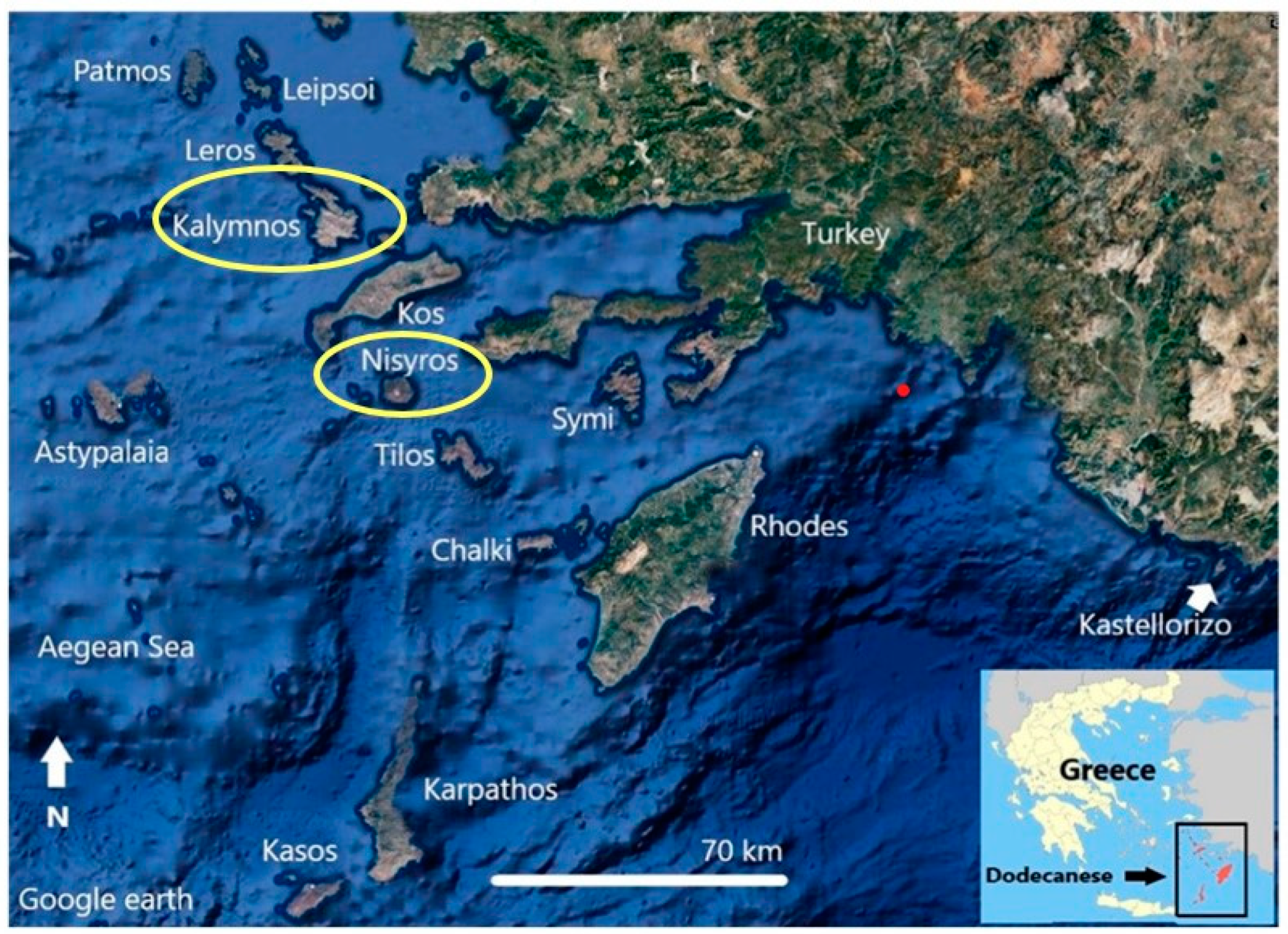
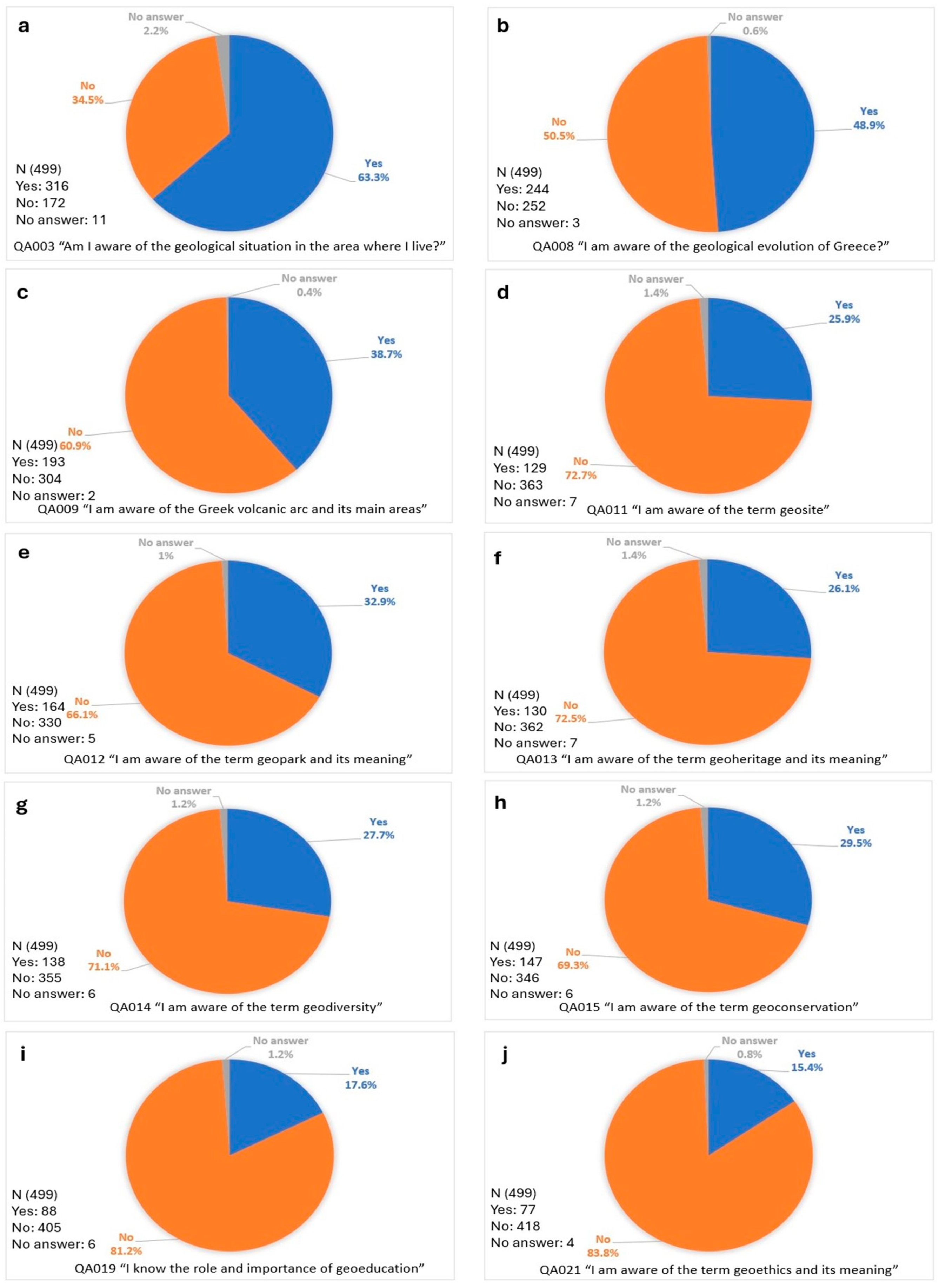
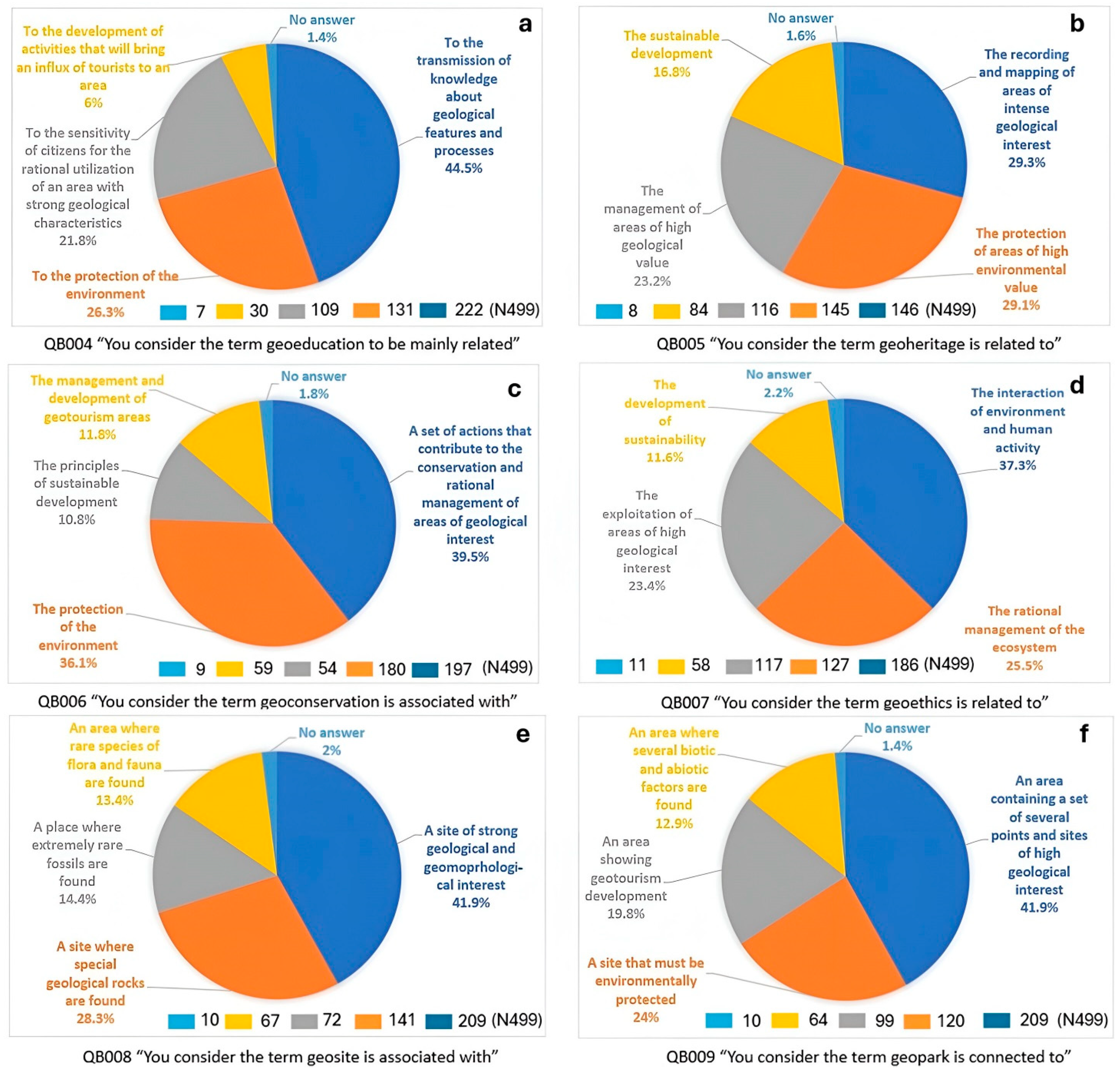

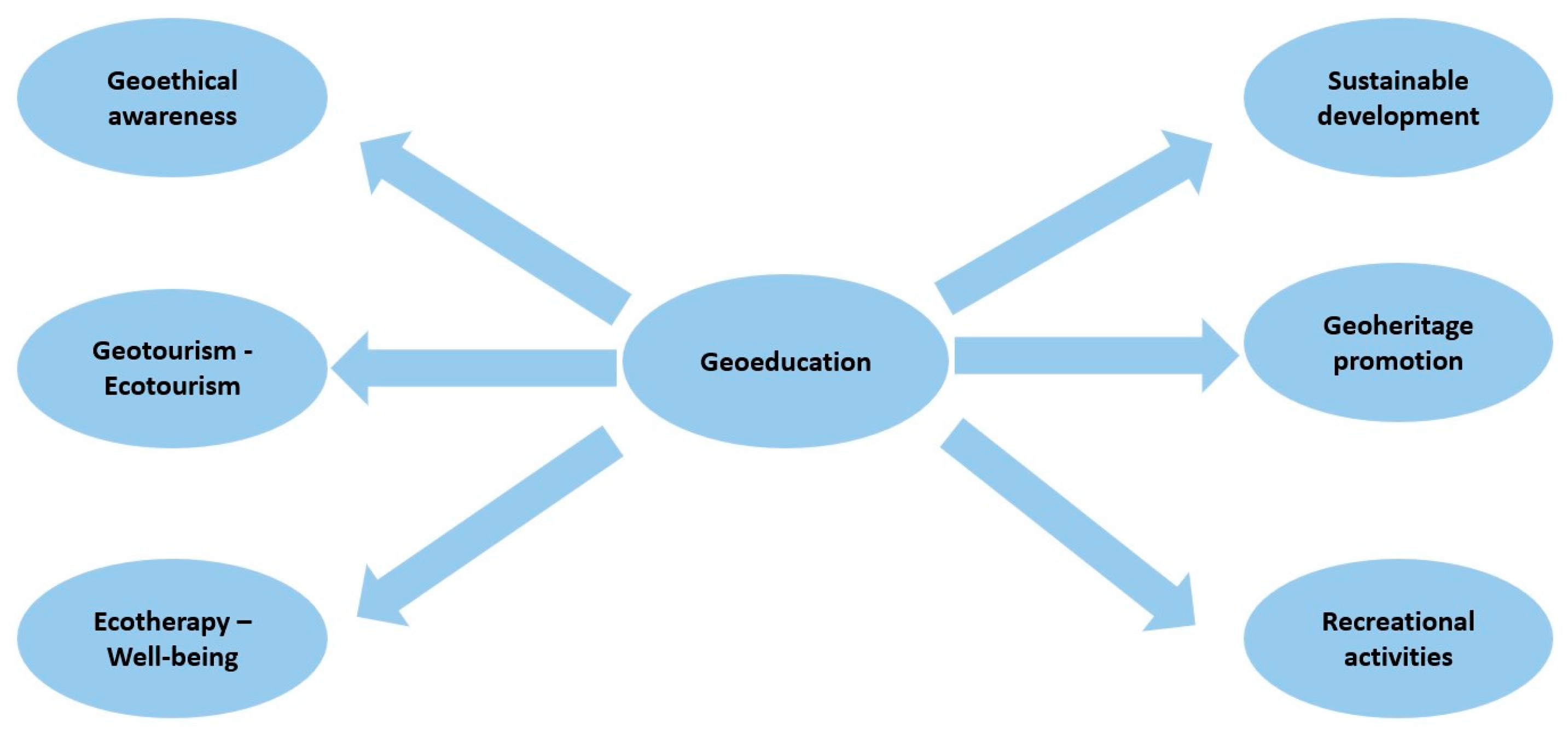
| Instructions: Indicate Whether Each Statement Is Correct or Incorrect by Marking “T” for True or “F” for False. | ||
|---|---|---|
| True | False | |
| 1. Most caves are formed naturally and not by man-made causes | ☐ | ☐ |
| 2. The concepts cave and hollow are different | ☐ | ☐ |
| 3. Stalactites are drops of water | ☐ | ☐ |
| 4. Stalagmites form at the base of a cave | ☐ | ☐ |
| 5. Limestone as a rock has enough porosity | ☐ | ☐ |
| 6. In a cave there are only abiotic factors | ☐ | ☐ |
| 7. The climbing field is created in a mainly faulted area | ☐ | ☐ |
| 8. The main types of faults fall into three categories | ☐ | ☐ |
| 9. Geoconservation refers to a set of activities related to the conservation and rational management of areas of intense geological importance | ☐ | ☐ |
| 10. Geoethics deal with the interaction of the environment and human activities based on respect for geological processes that have evolved over time. | ☐ | ☐ |
| 11. A geosite is not of geological or historical interest | ☐ | ☐ |
| 12. Geoeducation is linked to geotourism | ☐ | ☐ |
| 13. Geoeducation is linked to sustainable development | ☐ | ☐ |
| 14. A cave can be created in one year | ☐ | ☐ |
| 15. Cave speleothems are fossils | ☐ | ☐ |
| Choose the Correct Answer to the Following Questions | ||
|---|---|---|
| 1. Caves are created by | ||
| a. people | b. natural geological processes | c. both a and b |
| 2. Hollows can only be entered by | ||
| a. people | b. small animals | c. no organisms |
| 3. Caves contains | ||
| a. biotic factors | b. abiotic factors | c. both biotic and abiotic factors |
| 4. Stalactites are found | ||
| a. on the roof of a cave | b. on the floor of a cave | c. both a and b |
| 5. Stalagmites are found | ||
| a. on the roof of a cave | b. on the floor of a cave | c. both a and b |
| 6. A cave is created mainly inside | ||
| a. limestone rocks | b. granitic rocks | c. igneous rocks |
| 7. Limestone is | ||
| a. a metamorphic rock | b. a sedimentary rock | c. an igneous rock |
| 8. The life cycle of a cave is divided into | ||
| a. two stages | b. three stages | c. four stages |
| 9. A cave depending on temperature conditions can be divided into | ||
| a. four zones | b. three zones | c. two zones |
| 10. A geoeducational activity can be organized by | ||
| a. an educator of any direction | b. geologist | c. none |
| Please Indicate Your Level of Agreement with the Following Statements 1. Strongly Disagree, 2. Disagree, 3. Neither Disagree nor Agree, 4. Agree, 5. Strongly Agree | |||||
|---|---|---|---|---|---|
| 1 | 2 | 3 | 4 | 5 | |
| 1. The geoeducational program helped in understanding geological concepts and processes. | ☐ | ☐ | ☐ | ☐ | ☐ |
| 2. The geoeducational program increased awareness of the protection and conservation of the geoenvironment. | ☐ | ☐ | ☐ | ☐ | ☐ |
| 3. The geoeducational program strengthened the exploration of areas with significant geological content and fostered a geoethical culture. | ☐ | ☐ | ☐ | ☐ | ☐ |
| 4. The geoeducational program promoted the principles of sustainable development. | ☐ | ☐ | ☐ | ☐ | ☐ |
| 5. I would recommend this geoeducational program to others. | ☐ | ☐ | ☐ | ☐ | ☐ |
| 6. Geoeducation can be effectively developed using ICT. | ☐ | ☐ | ☐ | ☐ | ☐ |
| 7. This geoeducational program has a constructive effect on students’ attitude. | ☐ | ☐ | ☐ | ☐ | ☐ |
| 8. This geoeducational program contributes to the creation of a culture of citizens with a higher environmental consciousness. | ☐ | ☐ | ☐ | ☐ | ☐ |
| 9. Do you think that a geoeducational program contributes to the creation of a culture of citizens with a higher environmental attitude? | ☐ | ☐ | ☐ | ☐ | ☐ |
| 10. Do you think that during the geoeducational program you had the opportunity to develop skills such as communication, creativity, collaboration, and critical thinking? | ☐ | ☐ | ☐ | ☐ | ☐ |
Disclaimer/Publisher’s Note: The statements, opinions and data contained in all publications are solely those of the individual author(s) and contributor(s) and not of MDPI and/or the editor(s). MDPI and/or the editor(s) disclaim responsibility for any injury to people or property resulting from any ideas, methods, instructions or products referred to in the content. |
© 2024 by the authors. Licensee MDPI, Basel, Switzerland. This article is an open access article distributed under the terms and conditions of the Creative Commons Attribution (CC BY) license (https://creativecommons.org/licenses/by/4.0/).
Share and Cite
Zafeiropoulos, G.; Drinia, H. Evaluating the Impact of Geoeducation Programs on Student Learning and Geoheritage Awareness in Greece. Geosciences 2024, 14, 348. https://doi.org/10.3390/geosciences14120348
Zafeiropoulos G, Drinia H. Evaluating the Impact of Geoeducation Programs on Student Learning and Geoheritage Awareness in Greece. Geosciences. 2024; 14(12):348. https://doi.org/10.3390/geosciences14120348
Chicago/Turabian StyleZafeiropoulos, George, and Hara Drinia. 2024. "Evaluating the Impact of Geoeducation Programs on Student Learning and Geoheritage Awareness in Greece" Geosciences 14, no. 12: 348. https://doi.org/10.3390/geosciences14120348
APA StyleZafeiropoulos, G., & Drinia, H. (2024). Evaluating the Impact of Geoeducation Programs on Student Learning and Geoheritage Awareness in Greece. Geosciences, 14(12), 348. https://doi.org/10.3390/geosciences14120348







